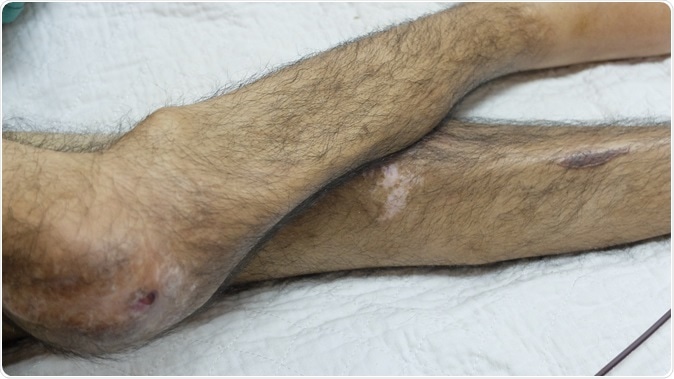According to latest research, the muscle wasting that is associated with ageing has been attributed to loss of nerves. Researchers from the Manchester Metropolitan University, The University of Manchester, The University of Waterloo in Ontario, and Central Manchester University Hospitals NHW Foundation Trust published their study findings in the latest issue of The Journal of Physiology.

Lower limbs showing sign of muscle wasting. Image Credit: Casa nayafana / Shutterstock
Loss of muscle mass with age is called sarcopenia and affects around 10 to 20 percent individuals over the age of 65 years. The new study looked at 95 men aged between 65 and 90 years with various degrees of sarcopenia. Their muscles were compared along with the nerve activity with 48 healthy young men aged between 18 and 40 years. Results showed that the older men as expected had a lower muscle mass compared to the younger men. In older men who did not have pronounced sarcopenia however, the nerve activity in the muscles remained high. This means that whatever little muscle they had lost, the nerves compensated for it.
Of the older men in the study, 13 did not have sarcopenia while 53 were likely to develop sarcopenia with time and were termed “pre-sarcopenic”. Of the study population, 29 had already developed sarcopenia. The nerve bundles or motor units of the muscles were much (by 63 to 65 percent) lower among the older adults with or without sarcopenia. Those with no sarcopenia had a 26 percent higher nerve activity than younger men. Similarly those with “pre-sarcopenia” had a 41 percent higher nerve activity than the younger individuals. Men with sarcopenia tended to have lower nerve activity.
The researchers could understand the muscle quality and quantity changes with age. They could say that maintaining healthy muscle mass with age could mean that quality of muscle activity was preserved for longer. The study however was a one-time study and following up the participants over time would have proved deeper insights feel experts. Following up individuals over years with or without adequate physical activities would provide a deeper understanding of how muscle movement and activity helps prevent muscle mass loss.
Prof Jamie McPhee, from Manchester Metropolitan University, explained that while younger persons have 60-70,000 nerves controlling movement of their legs down from the lower back or spine, this number declines with age. Around 30 to 60 percent nerves are lost he explained, and that leads to muscle wasting.
The researchers suggest that older adults must maintain healthy diet and also regular physical activity to keep their muscles strong and functioning. They are advised 150 minutes of moderate intensity activity per week (30 minutes 5 days a week for example) and strengthening exercises are recommended at least twice a week.
This research shows that with regular exercise and physiotherapy muscle wasting and loss may be prevented but recovery of the lost muscle fibres is not possible.
The study authors concluded that losing the nerve fibres to the muscles early during the ageing process is well known. However this study shows how the body can adapt and increase the nerve fibres to the muscles to preserve muscle mass.